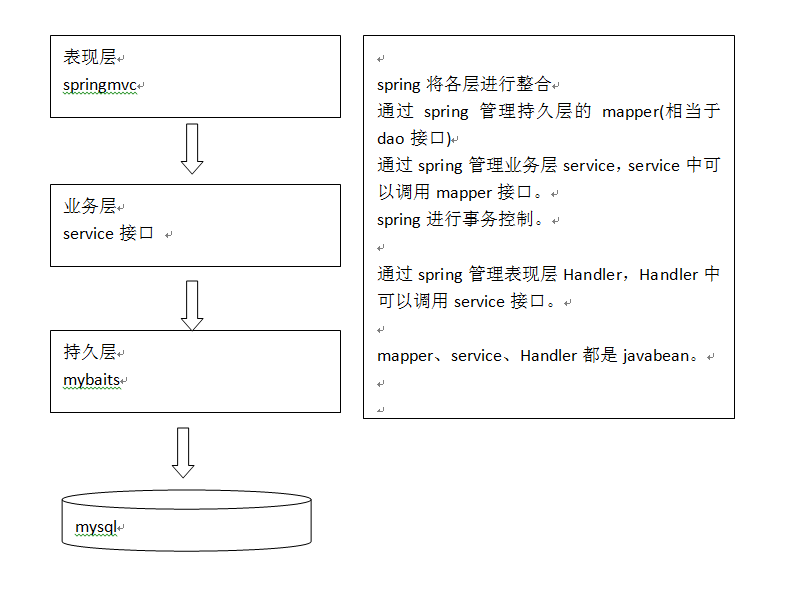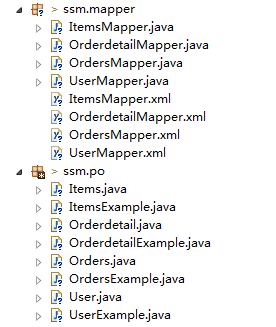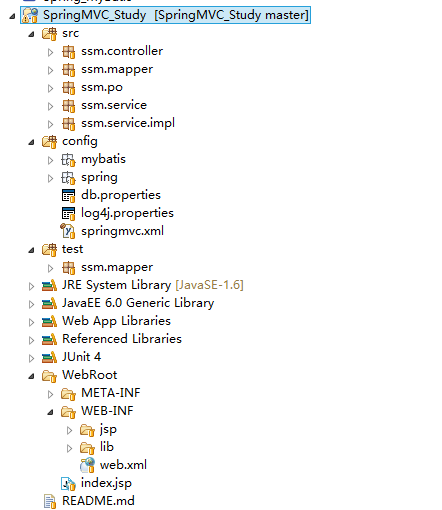转自:http://blog.csdn.net/eson_15/article/details/51700519
1. jar包管理
我之前有写过一篇spring、hibernate和struts2整合的文章,在整合的时候,我个人不喜欢乱,不喜欢啪叽一下将所有jar包往lib中一扔,因为那样没有条理,所以在整合SSM的时候,我还是遵循jar包分类的原则,首先看一下SSM整合都用到了哪些jar包(点我下载):

这里我用的是dbcp,当然也可以用c3p0等其他连接池,归归类后jar包就很有条理。
2. 整合思路
关于SSM的架构可以简单看一下下面的草图:

可以看出,spring在进行管理时,是很有条理的,每个层都由spring管理,然后不同的层可以调用其它层,Handler调用service,service调用mapper等。根据这个架构,我们来总结一下整合的思路,根据这个调用关系,我们可以从下往上一步步整合。
- 整合dao层。mybatis和spring整合,通过spring管理mapper接口。
使用mapper的扫描器自动扫描mapper接口在spring中进行注册。- 整合service层。通过spring管理 service接口。
使用配置方式将service接口配置在spring配置文件中。
实现事务控制。- 整合springmvc。由于springmvc是spring的模块,不需要整合。
现在思路清晰了,接下来就开始整合了。在整合前先看一下我整合完的工程结构:
3. 整合dao层
整合dao层也就是整合持久层,那么需要spring的核心包,持久层包,mybatis包,数据库以及连接池的包。所以将spring-persistence/spring-core/mysql-connector/mybatis/dbcp几个文件夹中的jar包拷贝到lib中。
3.1 mybatis全局配置文件
首先得写mybatis的全局配置文件sqlMapConfig.xml,如下:
<?xml version="1.0" encoding="UTF-8" ?>
<!DOCTYPE configuration
PUBLIC "-//mybatis.org//DTD Config 3.0//EN"
"http://mybatis.org/dtd/mybatis-3-config.dtd">
<configuration>
<!-- setting配置根据需要再添加 -->
<!-- 配置别名 -->
<typeAliases>
<package name="ssm.po"/>
</typeAliases>
<!-- mapper这里不需要配置了,因为跟spring整合后,在spring那边会进行mapper的扫描
但必须遵循:mapper.xml和mapper.java必须同名且在一个目录
-->
</configuration>
可以看出,整合的时候,这个全局配置文件已经很清爽了,基本没啥东东了,因为数据源啊、mapper啊啥的都交给spring去管理了。
关于db.properties和log4j.properties中的内容,我就不写了,可以参考我之前写的mybatis相关博文,也可以直接看我的源码。
3.2 配置spring配置文件
配置完了mybatis的全局配置文件后,接下来就要配置spring的配置文件了,spring的配置文件我将分类写在不同的文件中,都放在config/spring/目录下了,这里是对dao的整合,所以起名applicationContext-dao.xml。
<?xml version="1.0" encoding="UTF-8"?>
<beans xmlns="http://www.springframework.org/schema/beans"
xmlns:xsi="http://www.w3.org/2001/XMLSchema-instance"
xmlns:mvc="http://www.springframework.org/schema/mvc"
xmlns:context="http://www.springframework.org/schema/context"
xmlns:aop="http://www.springframework.org/schema/aop"
xmlns:tx="http://www.springframework.org/schema/tx"
xsi:schemaLocation="http://www.springframework.org/schema/beans
http://www.springframework.org/schema/beans/spring-beans-4.2.xsd
http://www.springframework.org/schema/mvc
http://www.springframework.org/schema/mvc/spring-mvc-4.2.xsd
http://www.springframework.org/schema/context
http://www.springframework.org/schema/context/spring-context.xsd
http://www.springframework.org/schema/aop
http://www.springframework.org/schema/aop/spring-aop-4.2.xsd
http://www.springframework.org/schema/tx
http://www.springframework.org/schema/tx/spring-tx.xsd">
<!-- 加载db.properties文件中的内容 -->
<context:property-placeholder location="classpath:db.properties"/>
<!-- 配置数据源dbcp -->
<bean id="dataSource" class="org.apache.commons.dbcp.BasicDataSource" destroy-method="close">
<property name="driverClassName" value="${jdbc.driver}" />
<property name="url" value="${jdbc.url}" />
<property name="username" value="${jdbc.username}" />
<property name="password" value="${jdbc.password}" />
<property name="maxActive" value="10" />
<property name="maxIdle" value="5" />
</bean>
<!-- 配置sqlSessionFactory -->
<bean id="sqlSessionFactory" class="org.mybatis.spring.SqlSessionFactoryBean">
<property name="dataSource" ref="dataSource" />
<property name="configLocation" value="classpath:mybatis/sqlMapConfig.xml"/>
</bean>
<!-- 配置mapper扫描器 -->
<bean class="org.mybatis.spring.mapper.MapperScannerConfigurer">
<!-- 扫描包的路径,如果需要扫描多个包,中间使用半角 逗号隔开-->
<property name="basePackage" value="ssm.mapper"/>
<property name="sqlSessionFactoryBeanName" value="sqlSessionFactory"></property>
</bean>
</beans>
可以看出,整合dao层的时候主要配置一下数据源、sqlSessionFactory和mapper扫描器,这样的话,数据源,sqlSessionFactory和mapper在tomcat启动时就被spring实例化到了容器中。接下来就是准备po类及mapper了。
3.3 逆向工程生成po类及mapper
关于如何使用mybatis的逆向工程我就不再赘述了,如果不太清楚的童鞋请看一下这篇文章:☞点我查看。
将生成的代码拷贝到我们自己的工程中即可,如下(那些文件前的问号不管它,是我还没同步到github的缘故):

到这里dao层就整合好了,下面来做个测试,整合的时候一定要步步为营,别啪啪啪整合完了再一起测试,到时候出错再找就不太方便了。我们针对ItemsMapper接口中的SelectByPrimaryKey()方法做一个测试:
public class ItemsMapperTest {
ApplicationContext applicationContext = null;
@Before
public void setUp() throws Exception {
applicationContext = new ClassPathXmlApplicationContext("classpath:spring/applicationContext-dao.xml");
}
@Test
public void testSelectByPrimaryKey() {
ItemsMapper itemsMapper = (ItemsMapper) applicationContext.getBean("itemsMapper");
Items items = itemsMapper.selectByPrimaryKey(1);
System.out.println(items);
}
}
能打印出id为1的Items对象说明没有问题。
3.4 一个小插曲
这里需要注意一个问题,刚刚逆向工程生成的代码,我们尽量不要去改动它,为什么呢?比如我现在改动了生成后的代码,后面万一需求改变,我肯定会根据新的表关系再生成一次,然后再拷到自己的工程,这样之前修改的东西就会被覆盖,如果又不想被覆盖,那就很麻烦了……要改的地方就太多了……所以我们永远不去修改生成之后的代码,如果有需要,我们在生成的代码基础上进行扩展(继承,组合等),这样就算代码重新生成,也不会影响我们的扩展类。
我举个例子:假如现在有个需求:
SELECT * FROM items WHERE items.name LIKE ‘%参数%’
这个参数我们要通过一个Items的包装类传进来,Items的包装类指的是,里面封装了Items的信息,还封装了其他信息。因为这个包装类除了查询Items相关信息外,还可能有关联查询,所以里面不仅仅就只有Items本身的信息。
要实现这个需求,我们不能直接去改Items类,不能直接在Items类中添加东西,原因上面已经分析了,我们可以这么做:
- 先写一个Items的继承类
- 在这个继承类上进行扩展
为啥要先写一个继承类呢?直接写Items的扩展类不就行了么?原因还是上面提到的,完以后面这个Items改了咋整?这是一点,还有就是Items的继承类里面,我就可以做一些新的操作了。看一下实现:
//Items的继承类
public class ItemsCustom extends Items {
//可以添加商品信息的扩展属性,如果不添加,其实就是Items
}
//这个就是Items的包装类,我们从service开始,传递下去的都是包装类
public class ItemsQueryVo {
//原始的商品信息
private Items items;
//为了系统 可扩展性,对原始生成的po进行扩展
private ItemsCustom itemsCustom;
public Items getItems() {
return items;
}
public void setItems(Items items) {
this.items = items;
}
public ItemsCustom getItemsCustom() {
return itemsCustom;
}
public void setItemsCustom(ItemsCustom itemsCustom) {
this.itemsCustom = itemsCustom;
}
}
然后我们定义itemsMapperCustom.xml映射文件:
<?xml version="1.0" encoding="UTF-8" ?>
<!DOCTYPE mapper PUBLIC "-//mybatis.org//DTD Mapper 3.0//EN" "http://mybatis.org/dtd/mybatis-3-mapper.dtd" >
<mapper namespace="ssm.mapper.ItemsMapperCustom" >
<!-- 定义商品查询的sql片段,就是商品查询条件 -->
<sql id="query_items_where">
<!-- 使用动态sql,通过if判断,满足条件进行sql拼接 -->
<!-- 查询条件通过ItemsQueryVo包装对象中的itemsCustom属性来传递-->
<if test="itemsCustom != null">
<if test="itemsCustom.name != null and itemsCustom.name != ''">
items.name LIKE '%${itemsCustom.name}%'
</if>
</if>
</sql>
<select id="findItemsList" parameterType="ssm.po.ItemsQueryVo"
resultType="ssm.po.ItemsCustom">
SELECT items.* FROM items
<where>
<include refid="query_items_where"></include>
</where>
</select>
</mapper>
当然咯,对应的mapper接口要定义一下:
public interface ItemsMapperCustom {
public List<ItemsCustom> findItemsList(ItemsQueryVo itemsQueryVo) throws Exception;
}
最后针对这个接口写一个测试类:
public class ItemsMapperCustomTest {
ApplicationContext applicationContext = null;
@Before
public void setUp() throws Exception {
applicationContext = new ClassPathXmlApplicationContext("classpath:spring/applicationContext-dao.xml");
}
@Test
public void testFindItemsList() throws Exception {
ItemsMapperCustom itemsMapper = (ItemsMapperCustom) applicationContext.getBean("itemsMapperCustom");
ItemsQueryVo itemsQueryVo = new ItemsQueryVo();
ItemsCustom itemsCustom = new ItemsCustom();
itemsCustom.setName("手机");
itemsQueryVo.setItemsCustom(itemsCustom);
List<ItemsCustom> itemsCustomList = itemsMapper.findItemsList(itemsQueryVo);
System.out.println(itemsCustomList);
}
}
可以看到,我们操作的都是Items的继承类ItemsCustom和包装类ItemsQueryVo,这个ItemsQueryVo将贯穿整条线,从service调用,到dao层。由逆向工程生成的原始的po类我们不去操作它们,除非是简单的查询,那么直接查即可。
3. 整合service层
先把jar包导了再说,整合service层需要配置事务了,所以要导入spring-aop中所有的jar包到lib中。
之前提到过,service是用来调用mapper的,mapper是用来操作数据库的,其实上面的小插曲中的测试代码就有点类似service层做的事,先获取mapper接口的代理对象,然后操作数据库。所以在service层,我们首先要获取mapper接口的代理对象,只不过在这里我们通过spring注入进来,然后通过这个代理对象去操作数据库。下面看一下整个整合的步骤:
3.1 先写service接口
public interface ItemsService {
public List<ItemsCustom> findItemsList(ItemsQueryVo itemsQueryVo) throws Exception;
}
可以看出,这个接口和上面那个mapper接口其实是一样的,当然并不是说一定一样,只不过这里要实现的逻辑都一样而已。
3.2 service实现类
public class ItemsServiceImpl implements ItemsService {
@Autowired
private ItemsMapperCustom itemsMapperCustom;
@Override
public List<ItemsCustom> findItemsList(ItemsQueryVo itemsQueryVo)
throws Exception {
//通过itemsMapperCustom查询数据库
return itemsMapperCustom.findItemsList(itemsQueryVo);
}
}
可以看出,实现类中是通过@Autowired注入itemsMapperCustom,这个itemsMapperCustom是上面那个插曲中定义的一个mapper。它会通过spring配的扫描器扫描到,并将对象装到spring容器中,然后在这注入进来,然后调用findItemsList方法来操作数据库。至于itemQueyVo,实际中,是将前台传来的数据封装进来,然后传进来的。这样就打通了service与dao之间的通道了。
3.3 配置applicationContext-service.xml
这里是第二个spring的配置文件了,还是在config/spring文件夹下面,主要是用来配置所有的service的,如下:
<?xml version="1.0" encoding="UTF-8"?>
<beans xmlns="http://www.springframework.org/schema/beans"
xmlns:xsi="http://www.w3.org/2001/XMLSchema-instance"
xmlns:mvc="http://www.springframework.org/schema/mvc"
xmlns:context="http://www.springframework.org/schema/context"
xmlns:aop="http://www.springframework.org/schema/aop"
xmlns:tx="http://www.springframework.org/schema/tx"
xsi:schemaLocation="http://www.springframework.org/schema/beans
http://www.springframework.org/schema/beans/spring-beans-4.2.xsd
http://www.springframework.org/schema/mvc
http://www.springframework.org/schema/mvc/spring-mvc-4.2.xsd
http://www.springframework.org/schema/context
http://www.springframework.org/schema/context/spring-context.xsd
http://www.springframework.org/schema/aop
http://www.springframework.org/schema/aop/spring-aop-4.2.xsd
http://www.springframework.org/schema/tx
http://www.springframework.org/schema/tx/spring-tx.xsd">
<!-- 商品管理的service -->
<bean id="itemsService" class="ssm.service.impl.ItemsServiceImpl"/>
</beans>
当然咯,如果使用注解的话,这里就不用配了,先用xml的方式吧。
3.4 配置applicationContext-transaction.xml
这里是第三个spring的配置文件了,还是在config/spring文件夹下面,主要是用来配置spring事务管理的,如下:
<?xml version="1.0" encoding="UTF-8"?>
<beans xmlns="http://www.springframework.org/schema/beans"
xmlns:xsi="http://www.w3.org/2001/XMLSchema-instance"
xmlns:mvc="http://www.springframework.org/schema/mvc"
xmlns:context="http://www.springframework.org/schema/context"
xmlns:aop="http://www.springframework.org/schema/aop"
xmlns:tx="http://www.springframework.org/schema/tx"
xsi:schemaLocation="http://www.springframework.org/schema/beans
http://www.springframework.org/schema/beans/spring-beans-4.2.xsd
http://www.springframework.org/schema/mvc
http://www.springframework.org/schema/mvc/spring-mvc-4.2.xsd
http://www.springframework.org/schema/context
http://www.springframework.org/schema/context/spring-context.xsd
http://www.springframework.org/schema/aop
http://www.springframework.org/schema/aop/spring-aop-4.2.xsd
http://www.springframework.org/schema/tx
http://www.springframework.org/schema/tx/spring-tx.xsd">
<!-- 事务管理器 -->
<!-- 对mybatis操作数据事务控制,spring使用jdbc的事务控制类 -->
<bean id="transactionManager" class="org.springframework.jdbc.datasource.DataSourceTransactionManager">
<!-- 数据源dataSource在applicationContex-dao.xml中配置了 -->
<property name="dataSource" ref="dataSource"/>
</bean>
<!-- 通知 -->
<tx:advice id="txAdvice" transaction-manager="transactionManager">
<tx:attributes>
<tx:method name="save*" propagation="REQUIRED"/>
<tx:method name="delete*" propagation="REQUIRED"/>
<tx:method name="update*" propagation="REQUIRED"/>
<tx:method name="insert*" propagation="REQUIRED"/>
<tx:method name="find*" propagation="SUPPORTS" read-only="true"/>
<tx:method name="get*" propagation="SUPPORTS" read-only="true"/>
<tx:method name="select*" propagation="SUPPORTS" read-only="true"/>
</tx:attributes>
</tx:advice>
<aop:config>
<aop:advisor advice-ref="txAdvice" pointcut="execution(* ssm.service.impl.*.*(..))"/>
</aop:config>
</beans>
这样service层就整合完了。接下来就是整合springmvc了。
4. 整合springmvc
上面提到过,springmvc是spring的一个模块,所以不需要整合,我们只需要加入springmvc所需的包即可,将springmvc文件夹下的jar包导入到lib中即可。关于springmvc的使用,在前面几篇文章都写了,这里为了完整性,也总结一下。
4.1 配置前端控制器
前端控制器要配置在WEB-INF/web.xml中,如下:
<?xml version="1.0" encoding="UTF-8"?>
<web-app xmlns:xsi="http://www.w3.org/2001/XMLSchema-instance" xmlns="http://java.sun.com/xml/ns/javaee" xsi:schemaLocation="http://java.sun.com/xml/ns/javaee http://java.sun.com/xml/ns/javaee/web-app_3_0.xsd" id="WebApp_ID" version="3.0">
<display-name>SpringMVC_Study</display-name>
<welcome-file-list>
<welcome-file>index.jsp</welcome-file>
</welcome-file-list>
<!-- 配置前端控制器DispatcherServlet -->
<servlet>
<servlet-name>springmvc</servlet-name>
<servlet-class>org.springframework.web.servlet.DispatcherServlet</servlet-class>
<init-param>
<param-name>contextConfigLocation</param-name>
<param-value>classpath:springmvc.xml</param-value>
</init-param>
</servlet>
<servlet-mapping>
<servlet-name>springmvc</servlet-name>
<url-pattern>*.action</url-pattern>
</servlet-mapping>
</web-app>
4.2 配置处理器映射器、处理器适配器和视图解析器
这里使用注解的方式配置,因为注解的方式比较简单。配置在springmvc.xml中
<?xml version="1.0" encoding="UTF-8"?>
<beans xmlns="http://www.springframework.org/schema/beans"
xmlns:xsi="http://www.w3.org/2001/XMLSchema-instance"
xmlns:mvc="http://www.springframework.org/schema/mvc"
xmlns:context="http://www.springframework.org/schema/context"
xmlns:aop="http://www.springframework.org/schema/aop"
xmlns:tx="http://www.springframework.org/schema/tx"
xsi:schemaLocation="http://www.springframework.org/schema/beans
http://www.springframework.org/schema/beans/spring-beans-4.2.xsd
http://www.springframework.org/schema/mvc
http://www.springframework.org/schema/mvc/spring-mvc-4.2.xsd
http://www.springframework.org/schema/context
http://www.springframework.org/schema/context/spring-context.xsd
http://www.springframework.org/schema/aop
http://www.springframework.org/schema/aop/spring-aop-4.2.xsd
http://www.springframework.org/schema/tx
http://www.springframework.org/schema/tx/spring-tx.xsd">
<!-- 一个配置节解决映射器和适配器的配置注解配置 -->
<mvc:annotation-driven></mvc:annotation-driven>
<!-- 扫描所有的Controller -->
<context:component-scan base-package="ssm.controller"></context:component-scan>
<!-- 配置视图解析器
进行jsp解析,默认使用jstl标签,classpath下得有jstl的包
-->
<bean class="org.springframework.web.servlet.view.InternalResourceViewResolver" />
</beans>
4.3 编写Controller(即Handler)
接下来写一个Controller,如下:
@Controller
public class ItemsController {
@Autowired
private ItemsService itemsService;
@RequestMapping("/queryItems")
public ModelAndView queryItems() throws Exception {
//调用service查找数据库,查询商品列表
//这里传入进去一个null表示没有附加条件,查询所有的。因为service中接收的是一个ItemsQueryVo对象
List<ItemsCustom> itemsList = itemsService.findItemsList(null);
//返回ModelAndView
ModelAndView modelAndView = new ModelAndView();
modelAndView.addObject("itemsList", itemsList);
modelAndView.setViewName("/WEB-INF/jsp/items/itemsList.jsp");
return modelAndView;
}
}
前台jsp页面还是第二篇博文中写的那个,没有变,就不写了。最后还有个重要的步骤就是加载spring容器。
4.4 加载spring容器
在web.xml中添加spring容器监听器,加载spring容器:
<!-- 加载spring容器 -->
<context-param>
<param-name>contextConfigLocation</param-name>
<param-value>classpath:spring/applicationContext-*.xml</param-value>
</context-param>
<listener>
<listener-class>org.springframework.web.context.ContextLoaderListener</listener-class>
</listener>
到此为止,spring、mybatis和springmvc就整合完了,开启tomcat,然后在浏览器中输入http://localhost:8080/SpringMVC_Study/queryItems.action即可查询出Items表中的信息,说明整合完成。
相关阅读:http://blog.csdn.net/column/details/spring-mvc.html
学习笔记源码下载地址:https://github.com/eson15/SpringMVC_Study























 2万+
2万+

 被折叠的 条评论
为什么被折叠?
被折叠的 条评论
为什么被折叠?








